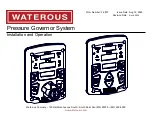
Part V–Effects
120
TASCAM SX-1
Reference Manual
down window where you can choose the reverb’s
shape directly. These shapes are available:
TIP
Always adjust the predelay according to the basic shape
you have chosen. Small rooms with a long predelay, for
example, sound very unusual.
SIZE
Size sets the size of the room by scaling the
early reflection pattern. By clicking on the
Size
label
above the display you will get a pop-up window.
Here you can choose a scaling factor for the room
size. A scaling factor of 1.0 is the original room size.
WALL DIFFUSSION
Wall Diffusion
determines how
much coloration the walls add to the sound. This
parameter is used to increase the reverb decay’s den-
sity. A
Diffusion
of 0% determines a value related to
the original sound character of the room settings
(including decay). You can change the
Diffusion
with
an offset of up to ±50%.
High Cut Filter
The input to the TC SX-1 Reverb
algorithm is processed with a low pass filter which
allows you to “roll off” the high frequencies of your
reverb effect. In general, you will want to make your
reverb effect a bit darker than the source signal, as it
might otherwise sound unnatural or even unpleasant.
HIGHCUT FILTER
Above the
HIGHCUT FILTER
win-
dow, there are two frequency values displayed. The
S
value is the start frequency of the high cut filter,
which is the lowest frequency influenced by the fil-
ter. The
E
value is the end value. This frequency is
where you have reached the determined attenuation.
The slider to the window’s right adjusts the actual
high frequency cut. And, the slider at the bottom of
the window adjusts the frequency position where
S
meets
E
.
Time Editor
DECAY/FREQUENCY
The reverb decay is a long
tail of reverberation that happens after the initial
burst. The Decay block receives its input from the
early reflection. Decay time can be edited distinctly
in 3 frequency ranges: low (L), mid (M), and high
(H). And the frequency-ranges themselves can also
be modified.
For each band you can set the decay time between
0.25 and 64 seconds. The sliders to the right of the
window adjust each band’s decay time. The two slid-
ers at the bottom of the window set the 2 crossover
points between the 3 frequency-ranges.
TIP
When designing your reverb, keep in mind that room
acoustics lose their high frequency energy more easily
over time. Setting the High Decay to a large amount of
time will usually make the room sound more artificial.
PREDELAYS
The predelays determine the starting
point for when the actual reverb effect will begin.
Hall
Simulates the early reflection mea-
sured in the Boston Symphony Hall.
Horseshoe
Incorporates some ideas from the
design of the Musikvereinssaal in
Austria.
Prism
Has a pattern based on the concep-
tual ‘golden ratio’ shoe box hall.
Fan
Is based on the basic structure of the
La Scala Concert Hall.
Club
Is based on a regular small club
room.
Small
Simulates a small domestic room.
















































